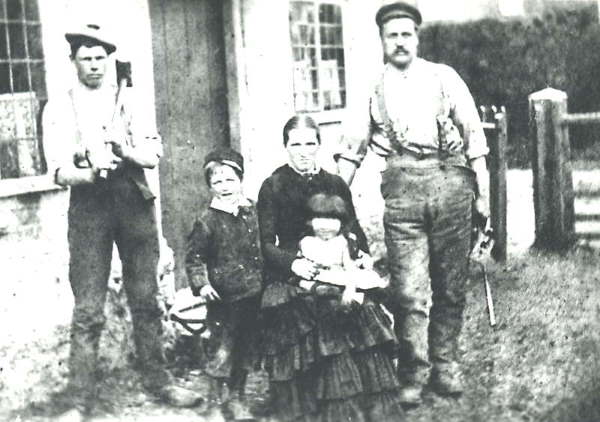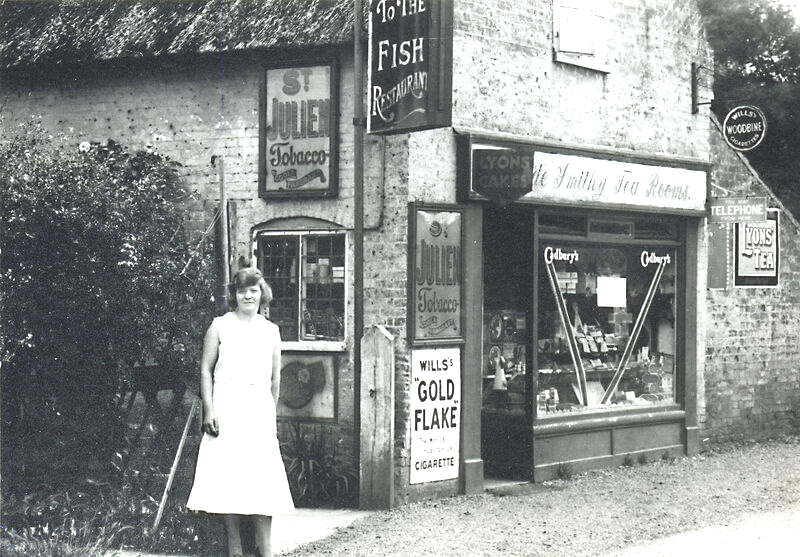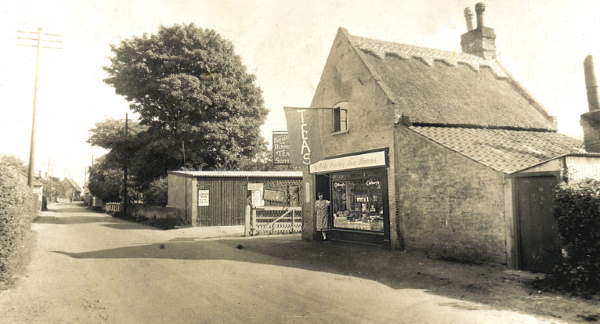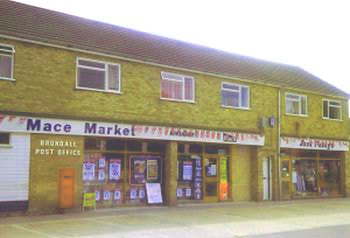We publish The Brundall and Braydeston Chronicle quarterly for our members. Click here to view pdfs of some previous editions.
Why our archive is worth preserving
Here is an example of how our archive can shine a light on the village of Brundall over the decades.
The first picture shows the blacksmith and his family outside the smithy around 1884, judging by the ages of the children in census returns.
The smith was Robert Gowing (or Gowen) and his wife was Christiana Harper, one of 10 children of John Harper, the landlord of the Ram Inn. Their children were Robert, born 1876 and Rosa Elizabeth, born 1882. The young man is perhaps an employee or apprentice.
Robert Gowing was born in Buckenham in 1854, and was still working as the village blacksmith in 1911.
The next two show Elsie Butcher at what had become the Old Smithy Tea Rooms in 1932 and 1933. The shop, in her front room, had a fish and chip shop and tea-rooms attached, called Ye Olde Smithy Tea Rooms after the smithy which had stood on the site. She took over the shop in the 1930s, and continued to 1956 when she retired. She died in 1992.
The final photo shows the same site which had become the Mace Market, with a dress shop, Just Fancy’s, next door. The general store became a Mace Market in 1965. The store is now Brundall's Co-op (one of two Co-ops in the village) and Post Office.
PLEASE NOTE: Our photographs are copyright. We may give permission to reproduce them, if asked; we welcome voluntary donations to help support our work.
The first picture shows the blacksmith and his family outside the smithy around 1884, judging by the ages of the children in census returns.
The smith was Robert Gowing (or Gowen) and his wife was Christiana Harper, one of 10 children of John Harper, the landlord of the Ram Inn. Their children were Robert, born 1876 and Rosa Elizabeth, born 1882. The young man is perhaps an employee or apprentice.
Robert Gowing was born in Buckenham in 1854, and was still working as the village blacksmith in 1911.
The next two show Elsie Butcher at what had become the Old Smithy Tea Rooms in 1932 and 1933. The shop, in her front room, had a fish and chip shop and tea-rooms attached, called Ye Olde Smithy Tea Rooms after the smithy which had stood on the site. She took over the shop in the 1930s, and continued to 1956 when she retired. She died in 1992.
The final photo shows the same site which had become the Mace Market, with a dress shop, Just Fancy’s, next door. The general store became a Mace Market in 1965. The store is now Brundall's Co-op (one of two Co-ops in the village) and Post Office.
PLEASE NOTE: Our photographs are copyright. We may give permission to reproduce them, if asked; we welcome voluntary donations to help support our work.
Find out about our archive and the work to catalogue it for the future
It was Sheila Evans, Brundall’s first county library assistant from 1974, who began collecting photographs and documentary evidence of the village’s past for the benefit of local schoolchildren and thus laid the foundation of a future archive.
In 2005, as The Book of Brundall and Braydeston was in preparation, a group of local enthusiasts embarked on a comprehensive investigation into Brundall’s history. This led not only to a renewed study of the scrapbooks but also the donation by local people of hundreds of photographs, documents and oral history accounts. Following publication of the book in 2007, and as a result of the success of this gargantuan team effort co-ordinated by Barbara Ayers, BLHG was formally founded.
At the time, most of the collected material was digitised by founder member Gerry Hawkins and originals gratefully returned to their owners. Sound recorded interviews and the scrapbooks were transferred to Norfolk Record Office. Since then, new digital images have been added continuously to the collection.
An archive group has now begun the important job of cataloguing the collection, and more volunteers are welcome to join the afternoon sessions once a week. The work was started in association with the Norfolk Record Office's Community Archives: Skills, Support and Sustainability Project, which was supported by the National Heritage Lottery Fund.
If you would like to find out more about our archive group's work, email [email protected]. You don't have to be an expert - just prepared to have a go at this interesting work with our friendly group.
Copyright: Nothing on this website may be copied or published without the permission of the Brundall Local History Group. This does not mean we will not give permission, but you do have to ask us. The archive material has come from many sources and there are many copyright holders.





